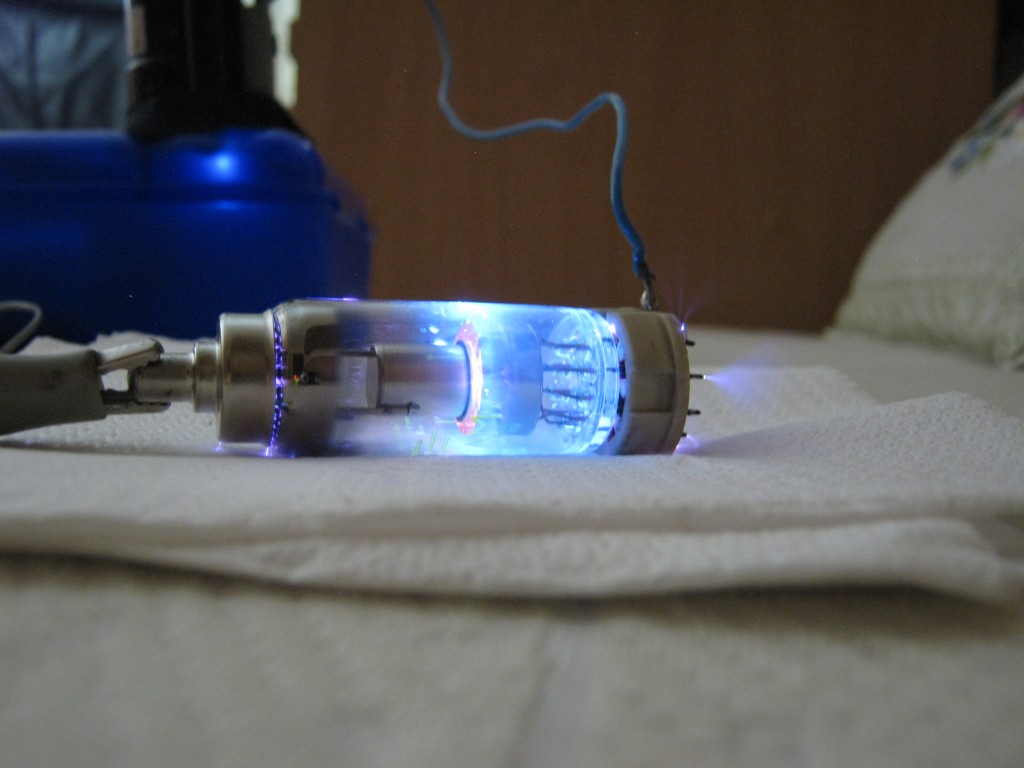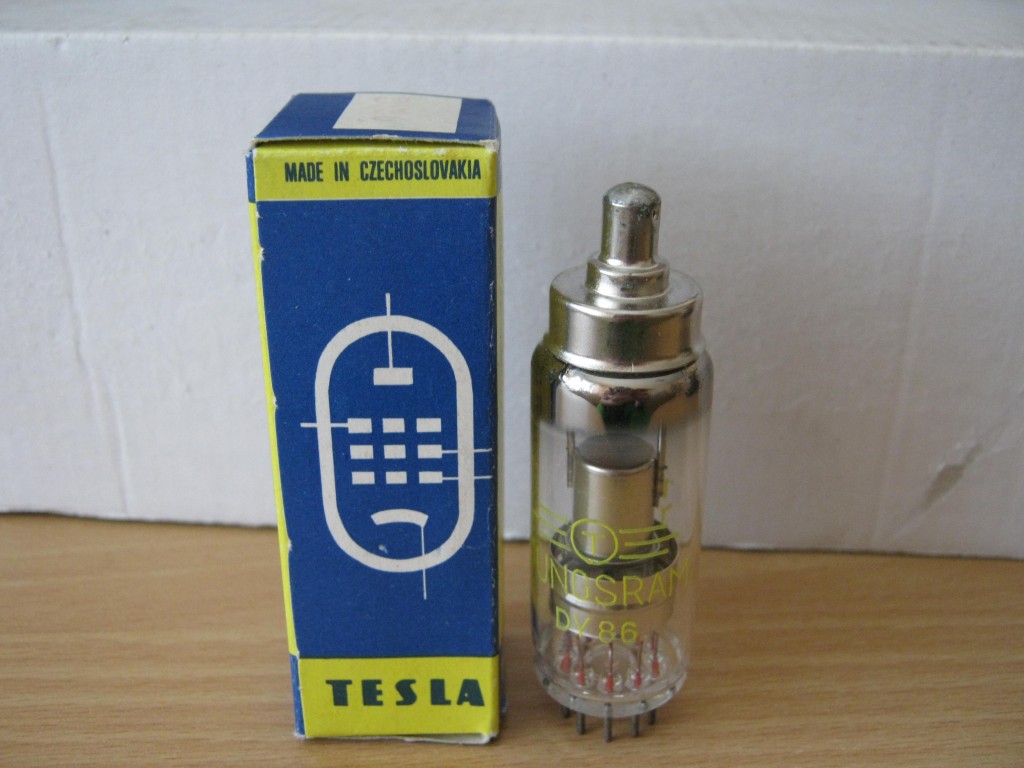The DY86 (DY87, DY802) vacuum rectifier was used in most European black and white tube television sets. In hot-cathode mode, it was capable of rectifying up to 18 kilovolts at 0.5 mA. In cold-cathode mode, however, it withstands 40 kilovolts DC inverse for a short time, while providing some soft X-ray radiation enough to set classic Geiger counters off.
As mentioned above, this tube withstands great abuse to its limiting values, this is thanks to the internal simplicity of construction. I have tried numerous low-powered (not to melt the tube, that’s why) high voltage drivers for experiments with this; ranging from single-transistor flyback drivers, AC-flyback multiplier supplies, to resonant DST-flyback drivers. With a great deal of experimentation, the maximum voltage in cold-cathode mode is something over 45 kilovolts DC at forward direction, while producing lesser X-ray output and heating the anode more, because of greater current draw.
A much better result is at reverse polarity (something over 40 kilovolts DC allowed, before sparks start to crawl along the glass base). This consumes less current and provides somewhat more soft X-rays to be detected. You can also see the cathode glow white hot. 🙂 Not a single damn was given, who would use a rectifier like this nowadays.
 DY86 @ 40 kV in reverse polarity
DY86 @ 40 kV in reverse polarity
Exposure 1 sec, notice corona near the anode
In forward polarity (regulated resonant HV supply). Glows more, emits less.
Unfortunately, the radiation output is not enough to make radiographs or anything somewhat interesting. I had prepared some intensifying screens and a camera set to a few second exposure (5 to 10), however despite setting all my Geigers off ticking and maybe some random photon particles, hitting the CCD sensor, were noticed in long-exposure photos afterwards (as random colorful dots, “bad pixels”), it was not possible to make x-ray photos this way.
To get some pictures from this setup, one would need longer exposures, like a minute or so, to a photosensitive film in a dark room, then developing it afterwards. But instead of doing this, I had already advanced to better X-ray setups at that time. 🙂
Measuring radiation intensity with an IT-65, in both polarities
Endurance test with low voltage, from a different supply – not enough to create X-rays
Notice the occasional Geiger counter ticks – just a slight deviation from atmospheric radiation.

Hi, I had some success with a pulse driver circuit similar to a gas igniter.
Seems to be peak voltage is the significant factor, with my setup it was “hot” enough to make a scintillator glow through a black plastic project box.
Incidentally try fiddling with the drive and amplitude, worked for me.
Hi Jozef, I know this topic is too old but I have questions for you. Can it be possible to run this tube with a premade marx generator from eBay? It musn’t be efficent too much.. Can they produce enough kick for arcing in tube and producing xrays? They labeled as “DC 3.6V to 40kV High-voltage Generator”. Keeping the things portable and small is my goal. If your answer is no, I will try a zvs flyback circuit and I will find a good spot for xrays with changing input voltage between 12-40v and looking at geigers output. Making a lot clicks on my geiger is enough for me. But is it really impossible to make pictures with this tube? I have some different colour fluorescent casettes. Can this tube make them glow with more exposure time maybe? I planned to make a homemade xray machine a few years ago but real xray tubes are pricey so I am trying to find another way. Thank you, best regards.
Hi there, GREAT SITE. i have always wondered if a stungun/taser could generate x-rays…. Well enough to illuminate a flouroscope? Maybee run a hv rectifier tube , cold cathode reverse bias. Atun guns produce 100kv-1MV, and sure would be safer than a lot of hv supplies, tho i imagine you would need a lot more current than a taser could supply.
Nope, stun guns have a small flyback inverter that produces up to 20-25 kV peaks, not more. Besides, the spark gap of the “taser” actually limits the voltage (the distance between the electrodes in air makes the spark strike). “100kV-1MV” is just marketing bullcrap.
Regards
Hello. That is very good. Geiger counter goes off. Nice work. I am not new in chemistry and physics. But i need your help. I bought one DY86 tube. But i don’t have enought time and money for making a power supply like yours. Can i use my Marx Generator? That produces 30kv-100kv. I will use it in mineral oil so i have a flourescent paper from hospital. I need to power DY86 for minimum 1 minute for making good pictures. Is it okay to use marx generator? Thank you
If you have a marx, your best bet would be a flash x-ray tube.
You won’t get sharp pictures with a tube like this though. Also, you will need a photosensitive paper, developing it afterwards – I highly doubt you are going to produce enough radiation to make pictures in realtime.
So i will find a classic x-ray tube and i will power it directly with marx generator like you said. I don’t want to damage xray tube (when i get it) and my marx generator. Can it be possible to damage xray tube with 60kv and current smaller than 500A? Thank you for your reply
Nope. Either build or get a constant-wave power supply, in conjunction with a hot cathode X-ray tube, or if you want your Marx of any use, get a flash x-ray tube.
“Can it be possible to damage xray tube with 60kv and current smaller than 500A”
I think not, 30 megawatts of input power is nothing… with regards on how the sentence is put 🙂
Sorry for 30 MW question 😀 I found a lot of sized 6 xray casettes and some films. I will be faceless and ask them for giving an old xray power supply and tube or just a flash xray tube from dentals 😀 Thank you for your help
Good luck. If all else fails, there are a couple of high voltage supplies’ schematics right on this page.